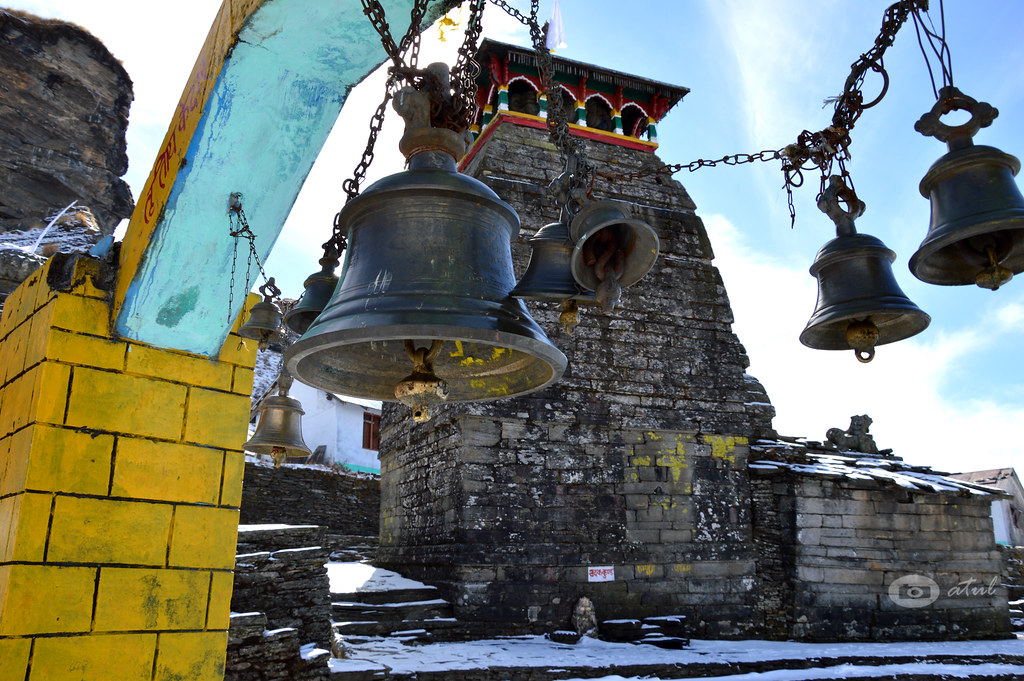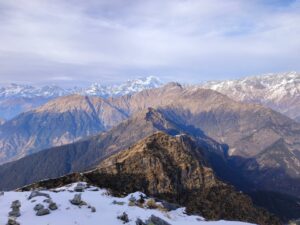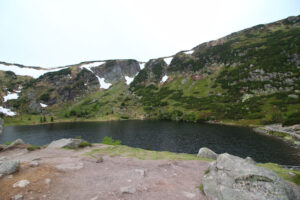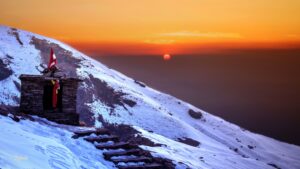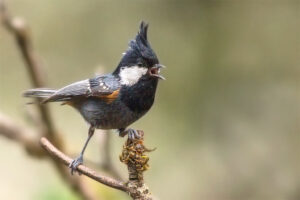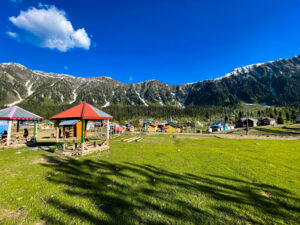High in the Garhwal Himalayas of Uttarakhand, Chopta feels alive with nature’s quiet magic. As you arrive, the cool wind carries the scent of pine and rhododendron, and the only sounds are birds calling from deep forests and the rustle of leaves underfoot. This peaceful hill station, often referred to as the “Mini Switzerland of India,” is framed by snow-dusted peaks that glow orange at sunrise. But Chopta is more than just a view — it’s a journey.
Top 10 Chopta Places to Visit
A gentle trek from here leads to Tungnath Temple, the highest Shiva temple in the world. The path winds through meadows where wildflowers nod in the breeze, and each step feels like you’re walking closer to the sky. Climb a little higher to Chandrashila Peak, and watch the first light touch Nanda Devi and Chaukhamba. In that golden silence, it’s hard not to feel something bigger than yourself. Chopta is untouched, unhurried, and unforgettable — a place where the mountains don’t just surround you, they speak to you.
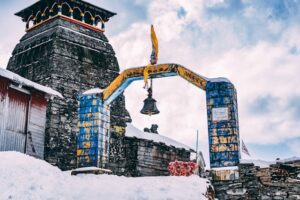
1. Tungnath Temple – Where Heaven Meets Earth
If you’re heading to Chopta, you can’t miss a visit to Tungnath Temple. It’s not just the highest Shiva temple in the world at 3,680 meters, but also a place where nature and spirituality meet most breathtakingly.
The trek from Chopta is about 3.5 km, but it doesn’t feel like a long hike — the path takes you through quiet pine and rhododendron forests, open meadows, and small streams. Every turn brings a new view of the snow-capped Himalayan peaks. By the time you reach the temple, you feel a mix of excitement and calm — it’s serene, ancient, and surrounded by mountains that seem endless.
- What to do: Trek (~3.5 km) from Chopta up to this highest Shiva temple, part of the Panch Kedar pilgrimage
- Best time: April–September (closed in winter due to snow)
- Entry fee: Free (pilgrimage site)
2. Chandrashila Peak – Touch the Sky
Just beyond Tungnath Temple lies Chandrashila Peak, one of the most rewarding Himalayan treks you can experience. Perched at around 4,000 meters, this peak offers panoramic views of the majestic Himalayan range, including Nanda Devi, Trishul, Chaukhamba, and Kedar peaks.
The trek from Tungnath to Chandrashila is short — about 1.5 km — but steep, so it’s best to go early in the morning. The path winds through rocky ridges and open meadows, giving trekkers a sense of climbing straight into the sky. The sunrise from Chandrashila is truly magical: golden light spreading across snow-capped peaks while the valleys below remain shrouded in mist.
- What to do: Continue a ~1.5 km steep trek from Tungnath for a 360° Himalayan panorama.
- Best time: Summer months (April–September)
- Fee: Free
3. Deoria Tal – A Lake of Reflections
If you’re visiting Chopta, a trip to Deoria Tal is a must for anyone who loves calm, natural beauty. Nestled at an altitude of around 2,430 meters, this high-altitude lake is surrounded by dense forests and snow-capped Himalayan peaks. It’s just a short drive and an easy trek from nearby villages, making it accessible for families, casual trekkers, and nature lovers alike.
What makes Deoria Tal truly special is its mirror-like waters. On a clear day, the lake perfectly reflects the surrounding peaks, including Chaukhamba and Nilkanth, creating a view so magical it feels almost unreal. The area is peaceful, away from crowds, and perfect for photography, camping, or simply sitting by the water and soaking in the serenity.
- What to do: Trek to this reflective alpine lake; ideal for camping, photography, and peaceful walks.
- Best time: Pre-monsoon and autumn (avoid winter)
- Fee: Free
4. Kanchula Korak Musk Deer Sanctuary – In Search of the Elusive Musk Deer

Located near Chopta in Uttarakhand, the Kanchula Korak Musk Deer Sanctuary is a serene and lesser-known gem for nature and wildlife lovers. Spread across dense Himalayan forests, this sanctuary is primarily famous for being home to the endangered Himalayan musk deer, a rare and elusive species that is rarely seen in the wild.
The sanctuary is also rich in biodiversity, with pine, oak, and rhododendron forests, and is home to other wildlife such as Himalayan langurs, leopards, Himalayan black bears, and various bird species. Trekking through the sanctuary gives visitors a chance to immerse themselves in pristine Himalayan wilderness, with fresh mountain air and tranquil surroundings
- What to do: Wildlife spotting—musk deer, Himalayan birds, rare flora.
- Best time: March–June and September–November
- Fee: Free
5. Ukhimath – The Winter Seat of the Gods
Ukhimath is a small town near Chopta in Uttarakhand, but it holds great spiritual significance. Known as the winter seat of Lord Kedarnath, the idol from Kedarnath Temple is moved here during the harsh winter months when the high-altitude temple is inaccessible. This makes Ukhimath an important destination for pilgrims.
The town is surrounded by dense forests and hills, offering a peaceful atmosphere away from the hustle of larger towns. It serves as a base for treks to Chopta, Tungnath Temple, and Chandrashila Peak, making it popular with both spiritual seekers and adventure enthusiasts.
What makes Ukhimath special is its blend of spirituality and nature. You can explore traditional Garhwali culture, visit local temples, and enjoy the fresh mountain air. Staying here gives you easy access to Chopta’s treks while also providing a glimpse into the Himalayan way of life
- What to do: Visit the spiritual town hosting Omkareshwar Temple; cultural immersion. Charchachowk
- Best time: Year-round
- Fee: Temple entry is free
6. Sari Village – Where Your Himalayan Story Begins
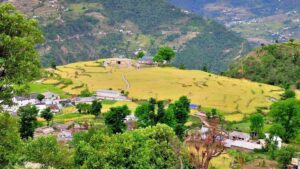
The road narrows as you climb higher into the Garhwal Himalayas. The bustling towns fall away, replaced by terraced fields and forests alive with birdsong. And then you see it—a quiet little village perched on the mountainside, wooden houses with slate roofs, smoke curling from chimneys. Welcome to Sari Village, the charming gateway to some of Chopta’s most magical trails.
Here, mornings start with the golden glow of the sun on distant peaks and the fragrance of fresh pine. Children wave as they walk to school along winding stone paths, and the sound of temple bells carries through the crisp mountain air. Sari isn’t just a stopover—it’s a pause, a chance to soak in the warmth of Garhwali hospitality before you set off for adventure.
Most travelers come here to begin their trek to Deoria Tal, but the village itself holds treasures for those who linger. Sip hot chai in a family-run homestay, taste simple but heartwarming pahadi food, or wander through apple orchards as the day slips lazily by. The pace is slow, the smiles are genuine, and every corner feels like a photograph waiting to be taken.
- Best time to visit: March to June and September to November for clear skies and pleasant weather.
- Things to do: Begin the Deoria Tal trek, stay in traditional homestays, explore village life, enjoy photography, and try local cuisine.
- Entry fee: None—just bring an open heart and trekking shoes.
7. Dugalbitta – Pause and Breathe
On the road from Ukhimath to Chopta, where the forests grow thicker and the mountains begin to rise like giants, there’s a little clearing you could almost miss—unless you slow down. That’s the secret of Dugalbitta. It isn’t a crowded tourist spot with long queues and souvenir stalls. It’s a quiet stop where the air feels cleaner, the sky looks bigger, and time seems to stretch just a little longer.
The name itself hints at its essence: dugal meaning “open space.” This small meadow opens like a window to the Garhwal Himalayas. On clear days, you can sit here with a steaming cup of chai and watch the sun brush snow peaks with gold. In spring, the rhododendrons splash the slopes with red and pink, while winter turns the ground into a soft white carpet.
Dugalbitta isn’t about doing more—it’s about doing less. Spend an hour, or spend a day. Walk through the forest paths listening to the wind whispering through the deodars. Stay in a wooden homestay where the only alarm clock is birdsong. Travelers often stop here on the way to Tungnath or Chandrashila, but those who linger find something rare: a feeling of being completely present.
- Best time to visit: March to June and September to November for pleasant weather; winter if you want snow.
- Things to do: Relax in the meadow, enjoy photography, sip tea in roadside dhabas, go birdwatching, or use it as a base for nearby treks.
- Entry fee: None—it’s nature’s invitation to slow down.Also Read this- https://thetripstairs.com/top-10-shimla-places-to-visit/
8. Chopta Bugyal Meadows – The Switzerland of Uttarakhand
They call it “The Switzerland of Uttarakhand”—but you won’t need a passport to witness this paradise. Chopta Bugyal Meadows is where velvet-green slopes meet snow-dusted Himalayan peaks, where clouds drift so low you feel you could scoop them with your hands, and where every breath feels cleaner, deeper, alive.At sunrise, the meadows are bathed in molten gold.
The wildflowers nod in the soft breeze as the silhouettes of Chaukhamba, Trishul, and Nanda Devi rise from the mist like sleeping giants. In winter, the same fields wear a crown of snow, glistening under an endless blue sky—an untouched playground for trekkers and nature lovers.
Walking here isn’t just a trek, it’s a slow-motion love letter to the mountains. Shepherd trails lead to hidden corners where you hear only birdsong and the whisper of the wind. Campfires light up the nights as the Milky Way arcs overhead in crystal clarity—no city lights, no noise, just the heartbeat of the Himalayas.
- March to May – for wildflowers and crisp air.
- December to February – for snow-laden meadows and magical winter treks.
- Things to do: Trekking to Tungnath–Chandrashila, birdwatching, stargazing, sunrise photography, or just lying on the grass and doing absolutely nothing.
9. Bisurital – The Hidden Blue Jewel

Somewhere high above the tree line, beyond winding trails and whispering forests, lies a lake so still and blue that it feels like a secret the mountains are guarding. Bisurital, perched at 4,000 meters in the Garhwal Himalayas, is not a place you stumble upon—it’s a treasure you earn.
The journey isn’t easy. The path is rugged, the climb demanding, and every turn tests your resolve. But with every step, the world grows quieter. You trade the chaos of cities for pine-scented air, for distant bird calls, for the crunch of earth beneath your boots. And then, suddenly, you see it—a sapphire mirror cradled by snow-kissed peaks, reflecting nothing but sky and silence.
Locals say Bisurital is blessed, a lake of purity where spirits wander freely under moonlit skies. Whether you believe the legends or just crave the rawness of untouched nature, this is where you’ll find it. No phone signal. No tea stalls. No crowds. Just you, the wind, and a sense of awe so deep it feels sacred.
Best time to visit:
- May to June – when snow begins to melt and trails open.
- September to October – for clear skies and crystal reflection
10. Rohini Bugyal – Meadows of Solitude
Not every beautiful place shouts for attention—some just wait quietly for you to arrive. Rohini Bugyal, a lesser-known meadow tucked along the Chopta–Tungnath trail, is one such secret. It isn’t crowded. It isn’t loud. And that’s exactly why it feels like stepping into a dream.
The trail winds through forests of oak and rhododendron, their branches painting dappled light on the path. The air smells faintly of pine, and somewhere in the distance, you can hear the chirping of Himalayan birds. Then the trees open up—and there it is. An endless green carpet rolling into the horizon, with the mighty Chaukhamba peaks standing guard in the distance.
Best Time to Visit
- April to June – for blooming wildflowers and mild temperatures.
- September to November – for clear skies and sweeping Himalayan views.
Things to Do at Rohini Bugyal
- Photography: Capture Chaukhamba and Kedarnath peaks in their raw beauty.
- Camping: Set up tents under a sky full of stars for an unforgettable night.
- Birdwatching: Spot the state bird of Uttarakhand, the vibrant Himalayan Monal.
- Trek onward: Use Rohini Bugyal as a scenic halt before Tungnath or Chandrashila.

